The alternative to this we are presently witnessing of two types at present. One type is what is happening in the middle East where one country (or religion) kills all other religions or countries (like ISIS).
The second type is what we are presently witnessing in Greece but could also theoretically happen to Spain, Italy or Portugal or other European countries where financial war is conducted against a financially weaker and less efficient country.
Unfortunately these are two of the models of how populations will be decimated in this century and beyond.
What is the reason for this?
The easiest way to put this would be to say that the ONLY reason we now have (for the first time in recorded history) 6 1/2 billion more people than are sustainable for thousands of years is OIL.
So, as the price of oil goes up because it is harder and harder to get out of the ground or ocean, standards of living will reduce and reduce around the world. Yes. It is also true that other sources of fuel and energy like Solar, wind, water, (hydrogen from water), natural gas, geothermal, and other energy sources likely will slowly replace oil for some people. But, the people this will help will primarily be the most developed countries on earth. And in the most developed countries we already have Zero population growth or less of the present populations living there.
Also, as more people around the world become more educated they also will tend to only replace themselves if that. Having 5 or 10 or more children will stop as people get more educated as to the consequences of that worldwide. But, that is a slow process over time.
So, we will see people dying naturally, the poorest from starvation and diseases because of no medical care or not enough, or we will see whole nations wiped out like we are presently witnessing in the Middle East with terrified masses of refugees struggling to survive the destruction of their homes, lives and countries in a somewhat biblical and historical way of thousands of years ago in the middle East.
Nature abhors imbalance and presently the human race is 6 1/2 billion people out of balance in regard to what the planet can sustain (just on the surface). So, literally all species (including humans) are now going extinct slowly or quickly in the 6th Great Extinction.
How this all turns out in the end is up to all of us. Will humanity be humane in this or will more and more people like ISIS just kill anyone of a different religion than them?
I know that thinking like this is difficult for us humans. We tend to think about helping our brothers and sisters across the planet. But, unless we deal with the harsh realities, we too will be the ones going extinct with all our children too. There needs to be more mechanisms in place through the United Nations regarding birth control otherwise the world will just become more and more violent and all civilization and compassion will be permanently lost to humans and then extinction will be inevitable.
We must face facts. Not doing so means actual extinction for everyone.
I believe a certain percentage of each nation should be able to survive. If the ratio of those that could survive if the number on earth was 1 billion was calculated we can see what that is.
For example: North America is 7.4% of the population of Earth. Therefore it could mean that 7.4% of the actual number of people of 1 billion could or would still be alive here. If I did this correctly 7.4% of 1 billion people would be 74 million people. Though this isn't pretty this is an example of how many people can actually live on the surface of North America for thousands of years. So, we would go from 544 million now to 74 million people. I know this sounds crazy but we are going for sustainability for thousands of years rather than for human extinction in this potential model of reality.
Here is the demographics of the world from Wikipedia:
Demographics of the world
From Wikipedia, the free encyclopedia
See also: World population
The demographic of the world include population density, ethnicity, education level, health measures, economic status, religious affiliations and other aspects of the population.According to the 2014 U.S. Census Bureau, the total population of the World was 7,257,877,500.[1]
Its overall population density is 50 people per km² (129.28 per sq. mile), without including Antarctica. Nearly two-thirds of the population lives in Asia and is predominantly urban and suburban, with more than 2.5 billion in the countries of China and India combined. The World's fairly low literacy rate (83.7%) is attributable to impoverished regions. Extremely low literacy rates are concentrated in three regions, the Arab states, South and West Asia, and Sub-Saharan Africa. Christianity, Islam, Hinduism and Buddhism are the four largest religions encompassing a little over 75% of the populace.[citation needed]
The world's largest ethnic group is Han Chinese. Although English (5.52%) is spoken by many as a second language, Mandarin Chinese (14.1%) and Spanish (5.85%) are the languages with the highest number of native speakers.
Human migration has been shifting toward cities and urban centers, with the urban population jumping from 29% in 1950, to 50.5% in 2005.[2] Working backwards from the United Nations prediction that the world will be 51.3 percent urban by 2010, Dr. Ron Wimberley, Dr. Libby Morris and Dr. Gregory Fulkerson estimated May 23, 2007 to be the first time the urban population outnumbered the rural population in history.[3] China and India are the most populous countries,[4] as the birth rate has consistently dropped in developed countries and until recently remained high in developing countries. Tokyo is the largest urban conglomeration in the world.[2][5]
The total fertility rate of the World is estimated as 2.52 children per woman, which is above the replacement fertility rate of approximately 2.1. However, world population growth is unevenly distributed, going from .91 in Macau, to 7.68 in Niger. The United Nations estimated an annual population increase of 1.14% for the year of 2000.[6]
There are approximately 3.38 billion females in the World. The number of males is about 3.41 billion. People under 14 years of age made up over a quarter of the world population (26.3%), and people age 65 and over made up less than one-tenth (7.9%) in 2011.[2]
The world population growth is approximately 1.09%[2]
The world population more than tripled during the 20th century from about 1.65 billion in 1900 to 5.97 billion in 1999.[7][8][9]
It reached the 2 billion mark in 1927, the 3 billion mark in 1960, 4 billion in 1974, and 5 billion in 1987.[10] Currently, population growth is fastest among low wealth, Third World countries.[11]
The UN projects a world population of 9.15 billion in 2050, which is a 32.69% increase from 2010 (6.89 billion).[7]
| World Population[12][13] | |
|---|---|
| Year | Million |
| 1500 | 458 |
| 1600 | 580 |
| 1700 | 682 |
| 1750 | 791 |
| 1800 | 978 |
| 1850 | 1,262 |
| 1900 | 1,650 |
| 1950 | 2,521 |
| 1999 | 5,978 |
| 2008 | 6,707 |
| 2014 | 7,215 |
Contents
History
Historical migration of human populations begins with the movement of Homo erectus out of Africa across Eurasia about a million years ago. Homo sapiens appear to have occupied all of Africa about 150,000 years ago, moved out of Africa 70,000 years ago, and had spread across Australia, Asia and Europe by 40,000 years BC. Migration to the Americas took place 20,000 to 15,000 years ago, and by 2,000 years ago, most of the Pacific Islands were colonized.Until c. 10,000 years ago, humans lived as hunter-gatherers. They generally lived in small nomadic groups known as band societies. The advent of agriculture prompted the Neolithic Revolution, when access to food surplus led to the formation of permanent human settlements. About 6,000 years ago, the first proto-states developed in Mesopotamia, Egypt's Nile Valley and the Indus Valley. Early human settlements were dependent on proximity to water and, depending on the lifestyle, other natural resources used for subsistence. But humans have a great capacity for altering their habitats by means of technology.
Since 1800, the human population has increased from one billion[14] to over seven billion,[15] In 2004, some 2.5 billion out of 6.3 billion people (39.7%) lived in urban areas. In February 2008, the U.N. estimated that half the world's population would live in urban areas by the end of the year.[16] Problems for humans living in cities include various forms of pollution and crime,[17] especially in inner city and suburban slums. Both overall population numbers and the proportion residing in cities are expected to increase significantly in the coming decades.[18]
Cities
The World has hundreds of major cities spread across 6 continents. Most are in coastal regions.As of 2005, the World had 62 metropolitan areas with a population of over 3,000,000 people each.[19]
As of 2010, about 3 billion people live in or around urban areas.[2]
The following table shows the populations of the top ten conglomerations.
| Rank | City | Population | Country | Statistical concept[20] | Area (km²)[21] |
|---|---|---|---|---|---|
| 1 | Tokyo | 36,669,000 | Metropolitan area[22] | 13,500 | |
| 2 | Delhi | 22,157,000 | Urban agglomeration[23] | 33,578 | |
| 3 | São Paulo | 20,262,000 | Metropolitan area (região metropolitana) | 8,050 | |
| 4 | Mumbai | 20,041,000 | Urban agglomeration | 1,097[24] | |
| 5 | Mexico City | 19,460,000 | Metropolitan area (zona metropolitana) | 7,815 | |
| 6 | New York | 19,425,000 | Metropolitan Statistics Area | 34,490[25] | |
| 7 | Shanghai | 16,575,000 | Urban agglomeration[26] | 3,920 | |
| 8 | Kolkata | 15,552,000 | Urban agglomeration | 1,026[27] | |
| 9 | Dhaka | 14,648,000 | Metropolitan area (megacity) | 1,600 | |
| 10 | Karachi | 13,125,000 | Urban agglomeration | 3,530 |
Population density
See also: List of countries by population density
Population density (people per km2) by country, 2006
Several of the most densely populated territories in the world are city-states, microstates or dependencies.[31][32] These territories share a relatively small area and a high urbanization level, with an economically specialized city population drawing also on rural resources outside the area, illustrating the difference between high population density and overpopulation.
Population distribution
| Region | Number | Percentage |
|---|---|---|
| Asia | 4,307,107,875 | 60% |
| Africa | 1,037,524,058 | 15% |
| Europe | 816,426,346 | 11.4% |
| North America | 544,620,340 | 7.6% |
| South America | 400,067,694 | 5.3998% |
| Australia/Oceania | 35,426,995 | 0.5% |
| Antarctica | 142,834 | 0.0002% |
| Total | 7,141,174,477 | 100.0% |
Ethnicity
Main article: Lists of ethnic groups
The world is made up of thousands of ethnic groups. Han Chinese represent about 18% of the global population.[33]Religion
Major denominations and religions of the world
Further information: List of religious populations
The table below lists religions classified by philosophy; however,
religious philosophy is not always the determining factor in local
practice. Please note that this table includes heterodox movements as
adherents to their larger philosophical category, although this may be
disputed by others within that category. For example, Cao Đài is listed because it claims to be a separate category from Buddhism, while Hoa Hao is not, even though they are similar new religious movements.The population numbers below are computed by a combination of census reports, random surveys (in countries where religion data is not collected in census, for example United States or France), and self-reported attendance numbers, but results can vary widely depending on the way questions are phrased, the definitions of religion used and the bias of the agencies or organizations conducting the survey. Informal or unorganized religions are especially difficult to count. Some organizations may wildly inflate their numbers.
countries with a historically large Christian population have experienced a significant decline in the numbers of professed active Christians: see demographics of atheism. Symptoms of the decline in active participation in Christian religious life include declining recruitment for the priesthood and monastic life, as well as diminishing attendance at church. On the other hand, since the 19th century, large areas of sub-saharan Africa have been converted to Christianity, and this area of the world has the highest population growth rate. In the realm of Western civilization, there has been an increase in the number of people who identify themselves as secular humanists. In many countries, such as the People's Republic of China, communist governments have discouraged religion, making it difficult to count the actual number of believers. However, after the collapse of communism in numerous countries of Eastern Europe and the former Soviet Union, religious life has been experiencing resurgence there, both in the form of traditional Eastern Christianity and in the forms of Neopaganism and Far Eastern religions.[citation needed]
Following is some available data based on the work of the World Christian Encyclopedia:[59]
| 1970–1985[60] | 1990–2000[61][62] | 2000–2005[63] |
|---|---|---|
| 2.74%: Islam | 2.13%: Islam | 1.84%: Islam |
| 3.65%: Bahá'í Faith | 2.28%: Bahá'í Faith | 1.70%: Bahá'í Faith |
| 2.34%: Hinduism | 1.69%: Hinduism | 1.57%: Hinduism |
| 1.64%: Christianity | 1.36%: Christianity | 1.32%: Christianity |
| 1.09%: Judaism | 1.87%: Sikhism | 1.62%: Sikhism |
| 1.67%: Buddhism | 1.09%: Buddhism | |
| 2.65%: Zoroastrianism | ||
| The annual growth in the world population over the same period is 1.41%. |
Marriage
The average age of marriage varies greatly from country to country, and has varied through time. Women tend to marry at a younger age than men and currently varies from 17.6 for women in Niger, to 32.4 for women in Denmark while men range from 22.6 in Mozambique to 35.1 in Sweden.[66]Financial
In 2005 the lowest 10% controlled 2.5% of the total world's income, while the top 10% controlled 28%.[2]In 2013, the poorest 3.5 billion people and the richest 85 people each controlled 1% of the world's wealth. The richest 1% owned 46% of the world's wealth.[67]
Health
Life expectancy varies greatly from country to country. It is lowest in certain countries in Africa and higher in Japan, Australia and Spain.
+80
+77.5
+75
+72.5
+70
+67.5
+65
|
+60
+55
+50
+45
+40
- 40
|
96% of the urban population has access to improved drinking water, while only 78% of rural habitants have improved drinking water. A total average of 87% of urban and rural have access to improved drinking water.
4% of the urban population does not have access to improved drinking water, leaving 22% of rural people without improved drinking water with a total world population of 13% not having access to drinking water.
76% of the urban population has access to sanitation facilities, while only 45% of the rural population has access. A total world average of 39% do not have access to sanitation facilities.
As of 2009, there are an estimated 33.3 million people living with HIV/AIDS, which is approximately 0.8% of the world population, and there have been an estimated 1.8 million deaths attributed to HIV/AIDS.
As of 2010, 925 million people are undernourished.[69]
Life Expectancy at Birth:
- total population: 67.07 years
- male: 65.21 years
- female: 69.05 years (2011 est.)
- total: 41.61 deaths/1,000 live births
- male: 43.52 deaths/1,000 live births
- female: 39.55 deaths/1,000 live births (2011 est.)
Demographic statistics
The following demographic statistics are from the CIA World Factbook, unless otherwise indicated.[70]Age structure
Median age by country. A youth bulge is evident for Africa, and to a lesser extent for South and Southeast Asia and Central America.
Main articles: Population pyramid and List of countries by median age
According to the 2006 CIA World Factbook, around 27% of the world's population is below 15 years of age.[71]- 0–14 years: 26.3% (male 944,987,919/female 884,268,378)[2]
- 15–64 years: 65.9% (male 2,234,860,865/female 2,187,838,153)[2]
- 65 years and over: 7.9% (male 227,164,176/female 289,048,221) (2011 est.)[2]
- Median Age - 28.4 years (male: 27.7 years, female: 29 years, 2009 est.)
Population growth rate
Growth rate of world population (1950-2000)
Main article: Population growth
Globally, the growth rate of the human population has been declining since peaking in 1962 and 1963 at 2.20% per annum. In 2009, the estimated annual growth rate was 1.1%.[72] The CIA World Factbook gives the world annual birthrate, mortality rate, and growth rate as 1.915%, 0.812%, and 1.092% respectively[73] The last one hundred years have seen a rapid increase in population due to medical advances and massive increase in agricultural productivity[74] made possible by the Green Revolution.[75][76][77]The actual annual growth in the number of humans fell from its peak of 88.0 million in 1989, to a low of 73.9 million in 2003, after which it rose again to 75.2 million in 2006. Since then, annual growth has declined. In 2009, the human population increased by 74.6 million, which is projected to fall steadily to about 41 million per annum in 2050, at which time the population will have increased to about 9.2 billion.[72] Each region of the globe has seen great reductions in growth rate in recent decades, though growth rates remain above 2% in some countries of the Middle East and Sub-Saharan Africa, and also in South Asia, Southeast Asia, and Latin America.[78]
Some countries experience negative population growth, especially in Eastern Europe mainly due to low fertility rates, high death rates and emigration. In Southern Africa, growth is slowing due to the high number of HIV-related deaths. Some Western Europe countries might also encounter negative population growth.[79] Japan's population began decreasing in 2005.[80]
Population in the world increased from 1990 to 2008 with 1,423 million and 27% growth. As persons the increase was among highest in India 290 million and China 192 million. Population growth was among highest in Qatar 174% and United Arab Emirates 140%.[81]
| Rank | Country | Population (thousands) 2010 |
Population (thousands) 1990 |
Growth (%) 1990-2010 |
|---|---|---|---|---|
| World | 6,895,889 | 5,306,425 | 30.0% | |
| 1 | 1,341,335 | 1,145,195 | 17.1% | |
| 2 | 1,224,614 | 873,785 | 40.2% | |
| 3 | 310,384 | 253,339 | 22.5% | |
| 4 | 239,871 | 184,346 | 30.1% | |
| 5 | 194,946 | 149,650 | 30.3% | |
| 6 | 173,593 | 111,845 | 55.2% | |
| 7 | 158,423 | 97,552 | 62.4% | |
| 8 | 148,692 | 105,256 | 41.3% | |
| 9 | 142,958 | 148,244 | -3.6% | |
| 10 | 126,536 | 122,251 | -3.5% |
Birth rate
Countries by birth rate in 2008
| Years | CBR | Years | CBR |
|---|---|---|---|
| 1950–1955 | 37.2 | 2000–2005 | 21.2 |
| 1955–1960 | 35.3 | 2005–2010 | 20.3 |
| 1960–1965 | 34.9 | 2010–2015 | 19.4 |
| 1965–1970 | 33.4 | 2015–2020 | 18.2 |
| 1970–1975 | 30.8 | 2020–2025 | 16.9 |
| 1975–1980 | 28.4 | 2025–2030 | 15.8 |
| 1980–1985 | 27.9 | 2030–2035 | 15.0 |
| 1985–1990 | 27.3 | 2035–2040 | 14.5 |
| 1990–1995 | 24.7 | 2040–2045 | 14.0 |
| 1995–2000 | 22.5 | 2045–2050 | 13.4 |
Birth rates ranging from 10-20 births per 1000 are considered low, while rates from 40-50 births per 1000 are considered high. There are problems associated with both an extremely high birth rate and an extremely low birth rate. High birth rates can cause stress on the government welfare and family programs to support a youthful population. Additional problems faced by a country with a high birth rate include educating a growing number of children, creating jobs for these children when they enter the workforce, and dealing with the environmental effects that a large population can produce. Low birth rates can put stress on the government to provide adequate senior welfare systems and also the stress on families to support the elders themselves. There will be less children or working age population to support the constantly growing aging population.
Death rate
| Years | CDR | Years | CDR |
|---|---|---|---|
| 1950–1955 | 19.5 | 2000–2005 | 8.6 |
| 1955–1960 | 17.3 | 2005–2010 | 8.5 |
| 1960–1965 | 15.5 | 2010–2015 | 8.3 |
| 1965–1970 | 13.2 | 2015–2020 | 8.3 |
| 1970–1975 | 11.4 | 2020–2025 | 8.3 |
| 1975–1980 | 10.7 | 2025–2030 | 8.5 |
| 1980–1985 | 10.3 | 2030–2035 | 8.8 |
| 1985–1990 | 9.7 | 2035–2040 | 9.2 |
| 1990–1995 | 9.4 | 2040–2045 | 9.6 |
| 1995–2000 | 8.9 | 2045–2050 | 10 |
| Rank | Country | Death rate (annual deaths/1000 persons) |
|---|---|---|
| 1 | 17.23 | |
| 2 | 15.76 | |
| 3 | 15.18 | |
| 4 | 15.16 | |
| 5 | 15.01 | |
| 6 | 14.71 | |
| 7 | 14.59 | |
| 8 | 14.55 | |
| 9 | 14.32 | |
| 10 | 14.21 |
According to the World Health Organization, the 10 leading causes of death in 2002 were:
- 12.6% Ischaemic heart disease
- 9.7% Cerebrovascular disease
- 6.8% Lower respiratory infections
- 4.9% HIV/AIDS
- 4.8% Chronic obstructive pulmonary disease
- 3.2% Diarrhoeal diseases
- 2.7% Tuberculosis
- 2.2% Trachea/bronchus/lung cancers
- 2.2% Malaria
- 2.1% Road traffic accidents
According to Jean Ziegler (the United Nations Special Rapporteur on the Right to Food for 2000 to March 2008), mortality due to malnutrition accounted for 58% of the total mortality in 2006: "In the world, approximately 62 millions people, all causes of death combined, die each year. In 2006, more than 36 millions died of hunger or diseases due to deficiencies in micronutrients".[99]
Of the roughly 150,000 people who die each day across the globe, about two thirds—100,000 per day—die of age-related causes.[100] In industrialized nations, the proportion is much higher, reaching 90%.[100]
Sex ratio
Map indicating the human sex ratio by country.
Countries with more females than males.
Countries with the same number of males and females.
Countries with more males than females.
No data
|
The value for the entire world population is 1.01 males/female,[101] with 1.07 at birth, 1.06 for those under 15, 1.02 for those between 15 and 64, and 0.78 for those over 65.
The "First World" G7 members all have a sex ratio in the range of 0.95–0.98 for the total population, of 1.05–1.07 at birth, of 1.05–1.06 for the group below 15, of 1.00–1.04 for the group aged 15–64, and of 0.70–0.75 for those over 65.
Countries on the Arabian Peninsula tend to have a 'natural' ratio of about 1.05 at birth but a very high ratio of males for those over 65 (Saudi Arabia 1.13, United Arab Emirates 2.73, Qatar 2.84), indicating either an above-average mortality rate for females or a below-average mortality for males, or, more likely in this case, a large population of aging male guest workers. Conversely, countries of Eastern Europe (the Baltic states, Belarus, Ukraine, Russia) tend to have a 'normal' ratio at birth but a very low ratio of males among those over 65 (Russia 0.46, Latvia 0.48, Ukraine 0.52); similarly, Armenia has a far above average male ratio at birth (1.17), and a below-average male ratio above 65 (0.67). This effect may be caused by emigration and higher male mortality as result of higher Soviet era deaths; it may also be related to the enormous (by western standards) rate of alcoholism in the former Soviet states. Another possible contributory factor is an aging population, with a higher than normal proportion of relatively elderly people: we recall that due to higher differential mortality rates the ratio of males to females reduces for each year of age.
Total fertility rate
| Years | TFR | Years | TFR | Years | TFR |
|---|---|---|---|---|---|
| 1950–1955 | 4.95 | 2000–2005 | 2.60 | 2050–2055 | 2.21 |
| 1955–1960 | 4.89 | 2005–2010 | 2.53 | 2055–2060 | 2.18 |
| 1960–1965 | 4.91 | 2010–2015 | 2.50 | 2060–2065 | 2.15 |
| 1965–1970 | 4.85 | 2015–2020 | 2.45 | 2065–2070 | 2.13 |
| 1970–1975 | 4.45 | 2020–2025 | 2.41 | 2070–2075 | 2.10 |
| 1975–1980 | 3.84 | 2025–2030 | 2.37 | 2075–2080 | 2.07 |
| 1980–1985 | 3.59 | 2030–2035 | 2.34 | 2080–2085 | 2.05 |
| 1985–1990 | 3.39 | 2035–2040 | 2.31 | 2085–2090 | 2.03 |
| 1990–1995 | 3.04 | 2040–2045 | 2.27 | 2090–2095 | 2.01 |
| 1995–2000 | 2.73 | 2045–2050 | 2.24 | 2095–2100 | 1.99 |
In undeveloped countries on the other hand, families desire children for their labour and as caregivers for their parents in old age. Fertility rates are also higher due to the lack of access to contraceptives, generally lower levels of female education, and lower rates of female employment in industry.
Unemployment rate
8.7% (2010 est.) 8.2% (2009 est.) note: 30% combined unemployment and underemployment in many non-industrialized countries; developed countries typically 4%-12% unemployment (2007 est.)Demonym
- noun: Terran(s)
- adjective: Terran
Languages
A color-coded map of Europe showing the geographic distribution of languages.
Main article: Language family
The World has no official language although English is used widely as a lingua franca. The dominant language, spoken as a first language by 12.44% of the population, is Mandarin Chinese. Spanish is spoken by around 330 to 400 million people, predominantly in the Americas and Spain. Arabic is spoken by around 280 million people. Hindi is spoken by about 200 million speakers, mostly in India. Bengali is spoken by around 230 million people. Portuguese is spoken by about 230 million speakers in Portugal, Brazil, East Timor, and Southern Africa.There are numerous other languages, grouped into nine major families:
- Indo-European languages 46% (Europe, Western Asia, South Asia, North Asia, North America, South America, and Oceania)
- Sino-Tibetan languages 21% (East Asia)
- Niger–Congo languages 6.4% (Sub-Saharan Africa)
- Afro-Asiatic languages 6.0% (North Africa to Horn of Africa, and Western Asia)
- Austronesian languages 5.9% (Oceania, Madagascar, and Maritime Southeast Asia)
- Dravidian languages 3.7% (South Asia)
- Altaic languages (controversial combination of Turkic, Mongolic, and Tungusic families) 2.3% (Central Asia, North Asia (Siberia), and Anatolia)[104]
- Austroasiatic languages 1.7% (Mainland Southeast Asia)
- Tai–Kadai languages 1.3% (Southeast Asia)
Education
4.4% of GDP spent on Education (2007)[citation needed]total population: 83.7% over the age of 15 can read and write, 88.3% male and 79.2% female[citation needed] note: over two-thirds of the world's 793 million illiterate adults are found in only eight countries (Bangladesh, China, Egypt, Ethiopia, India, Indonesia, Nigeria, and Pakistan); of all the illiterate adults in the world, two-thirds are women; extremely low literacy rates are concentrated in three regions, the Arab states, South and West Asia, and Sub-Saharan Africa, where around one-third of the men and half of all women are illiterate (2005-09 est.)[citation needed]
As of 2008, the school life expectancy (primary to tertiary education) for a man or woman is 11 years.[citation needed]
See also
- Demographics of North America
- Demographics of South America
- Demographics of Asia
- Demographics of Africa
- Demographics of Oceania
- Demographics of Europe
- Demographics of Antarctica
References
- Since the Mongolic and Tungusic language families have only a relatively small number of speakers, the majority of the Altaic percentage represents speakers of Turkic languages
- Historically, the Bahá'í Faith arose in 19th century Persia, in the context of Shi'a Islam, and thus may be classed on this basis as a divergent strand of Islam, placing it in the Abrahamic tradition. However, the Bahá'í Faith considers itself an independent religious tradition, which draws from Islam but also other traditions. The Bahá'í Faith may also be classed as a new religious movement, due to its comparatively recent origin, or may be considered sufficiently old and established for such classification to not be applicable.
|
||||||
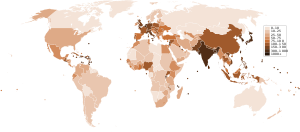
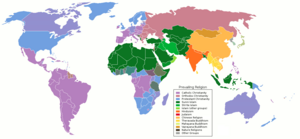

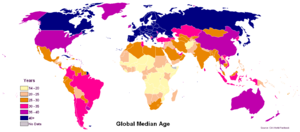
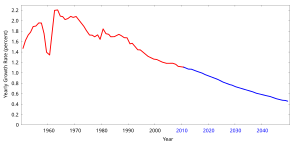

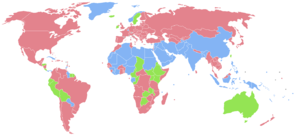

No comments:
Post a Comment